If you are looking for a low-maintenance indoor houseplant that is not only easy to grow but stunning to look at, then the Silver Sword Philodendron might be the perfect plant for you. This easy-going plant is a tropical vine that is a member of the Araceae family. While it does require some attention to its growing conditions, especially temperature, soil type, and lighting needs, it is easily adapted to its surroundings and thrives well with other plants of its type.

Its unique sliver sheen on leaves shaped like a sword are well- suited to its name. When given a place to climb and space to grow, the Silver Sword Philodendron will add a dazzling look to your houseplant collection.
What is the Philodendron Silver Sword Plant?
The Silver Sword plant, or Philodendron Hastatum is a native plant to the rain forests of Brazil. It grows under the canopy of trees in the forests near Rio De Janeiro and Mina Gerais. While these plants used to grow in abundance and were very common there, they are more recently found in greater quantities in greenhouses and stores. As their native habitat is being destroyed due to deforestation.
When you spot the Silver Sword the first thing you will likely notice is its glossy, silvery blue leaves. They have a distinct sword shape which as they grow can morph into a more arrowhead like shape. The Hastatum Philodendron is a climbing aroid plant, meaning it will hang on to surrounding plants as it grows and also borrow nutrients from those plants.
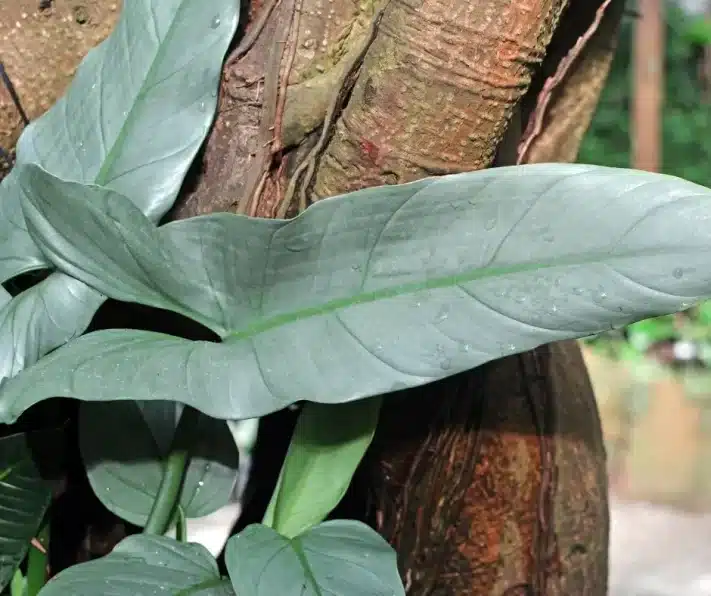
As an indoor houseplant the Silver Sword will grow fuller and more quickly if it is allowed to climb a moss pole or trellis. It also makes a stunning display as a trailing vine hung in a basket.
One interesting thing to note about this attractive houseplant is that it is considered a hemiepiphyte. It starts its life on the ground putting roots into the soil. As it climbs nearby plants and trees its nodes will reach out to those plants for nurturing. It will then eventually sever its root system and become an epiphyte.
Continue reading for a comprehensive guide on caring for this attractive and interesting Philodendron.
Silver Sword Plant at A Glance:
| Common Name: | Silver Sword |
| Botanical Name: | Philodendron Hastatum |
| Plant Type: | Tropical climbing vine |
| Size: | 6 inches – 10 feet (if allowed to climb) |
| Light: | Bright, indirect light |
| Soil: | Well-draining, loose, aerated |
| Water: | 2-3 times/week, when top 2 inches are dry |
| Vulnerabilities: | Small insects, waterlogging, fungal infections |
| USDA Growing Zones: | 9-11, mostly indoors |
Philodendron Silver Sword Plant Care Basics
Like many other plants of this species, the Philodendron Hastatum is a relatively simple houseplant to care for. Whether you choose to have it climb a moss pole or trail from a basket, this plant will look elegant and full in no time by following these basic guidelines for Silver Sword plant care.

What is the Best Soil?
When it comes to the best soil, this philodendron is not overly picky. It does prefer soil that is loose and airy so it does not hold on to too much moisture. It also helps if the pot has drainage holes so excess water is not sitting around the roots.
Because of its tropical, aroid up-bringing, soil that is high in organic substances is preferred, as much of the plant’s nutrients come from the other plants and air it is growing around.
Look for soil that has added organic matter such as earthworm castings. To provide aeration and moisture retention look for additives such as:
- Orchid bark
- Perlite
- Pumice
- Coco Coir
- Vermiculite
- Peat-moss
- Sphagnum moss

How Much Water Is Need?
Just like most tropical plants, the Silver Sword likes water but not too much water. It should stay moist without getting water-logged. Ideally you would water this houseplant 1 or 2 times per week but only if the top 2 inches of soil feel dry to the touch.
Fortunately, this Philodendron variety is one that enjoys water more than some. So if you do water it a little too much, no big deal. Its personality is also a good one for growing in terrariums as it can handle some of the extra moisture especially in well aerated soil or terrarium substrate.
How Much Light the Plant Need?
Again, the Silver Sword is not fussy when it comes to lighting needs. Since it grows naturally under the canopy of the rain forest it is used to getting bright sunlight through the shade of the taller trees. So as a houseplant it thrives best in bright, indirect light through windows that face either North or East.
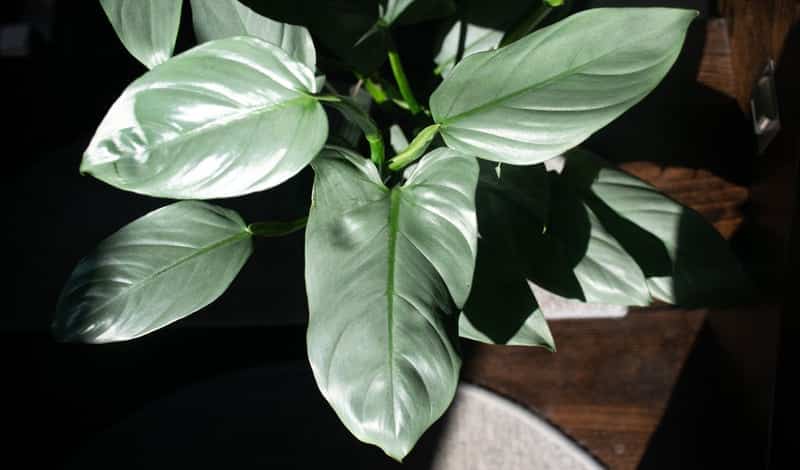
It will do ok in some less bright locations but you may lose some of the vibrant silver color and experience slower growth. It is also important to not expose this plant to too much sunlight as the bright, direct light can scorch the leaves and cause brownness or wilting.
What is the Ideal Temperature & Humidity?
This Philodendron grows naturally in the rain forest, so ideally its temperature and humidity levels are kept as close to rainforest conditions as possible. Ideal temperatures are anywhere between 65 to 80 degrees Farhenheit. While it can survive some colder temps as low as 50 or 60 degrees this should not happen often as it could damage the fragile leaves.
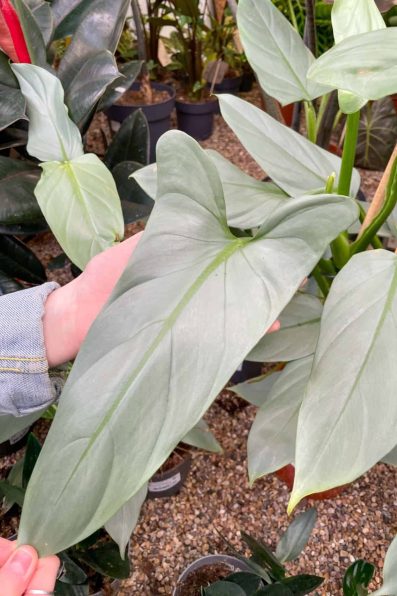
Humidity levels for the Silver Sword should be kept around the average range of 50-75% humidity. This can be difficult to maintain when growing indoors, especially during drier winter months. If your plant needs some help staying humid you can use a humidifier, pebble tray with water, or even mist the leaves from time to time.
What About Fertilizer?
Fertilizing the Silver Sword is not a necessity. It is a fast-growing, low-maintenance plant that does not seem to be overly fussy about its growing requirements. When it comes to fertilizer, it can be a nice addition for fuller growth but isn’t required.
If you do fertilize this plant, simply use a well-balanced liquid fertilizer that is specifically formulated for houseplants. Monthly feedings during the summer growing months and every 6-8 weeks during the winter and fall are sufficient for this plant’s nutritional needs.
Do I Need to Prune?
You do not NEED to prune the Silver Sword in order for it to thrive. The only time it might require some pruning is if you feel it is over-growing its space and taking over your other plants. It also tends to get a bit bushy, so if you want to manage its appearance you may want to cut back a few leaves.
Pruning is also recommended if you start to see leaves that are turning brown or yellow or that might appear to have a disease. Always remember to disinfect your pruning shears before cutting any leaves or stems.
What do I Need for Propagation?
You don’t need much for Silver Sword propagation. Just like everything else about growing this plant, the propagation process is simple too. The best way is to do a simple stem-cutting, and within weeks you’ll have several new plants to share with your fellow anthophiles.
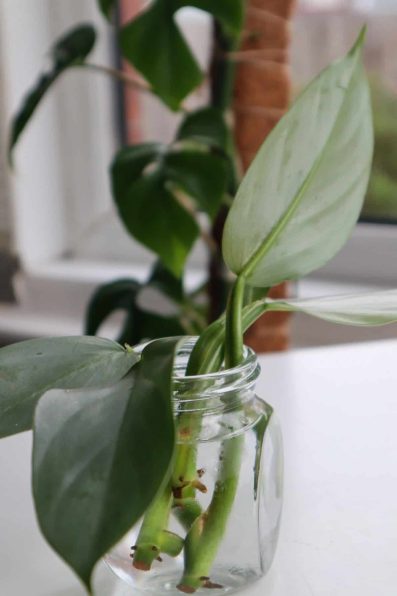
All you need to do:
- Make sure your Philodendron is healthy so the stem cutting has a chance to start with a nutrient-rich root system and grow into a strong plant.
- Using a clean, sharp shears, cut off a portion of the stem where you can see several nodes and at least 4 leaves. Look for portions towards the end of a vine so you aren’t removing a large part of the plant.
- Place the stem cutting in a jar of distilled, clean water.
- After 3-4 weeks you will see roots begin to sprout from the nodes. When the roots are a few inches long move them into a small pot with drainage holes that is filled with a nutrient-rich, well-draining soil.
Philodendron Silver Sword Varieties and Similar Plants
There are many varieties of the Philodendron species, but not all of them are as easy-going and simple to care for as the Silver Sword. And none are nearly as striking as the metallic color of this Philodendron Hastatum. However, if you’re looking for other low-maintenance tropical Philos, here are a few to consider.
Philodendron Birkin: One of the rarest species of Philodendron, the Birkin is actually a hybrid that was created through a mutation of the Philodendron Rojo Congo and the Green-leaf Philodendron. This combination left us with a striking deep-green plant with white pin stripes on its leaves.
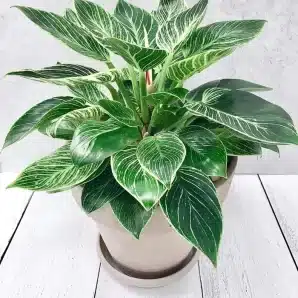
Philodendron Brasil: Another tropical climbing vine, the Brasil features a brilliant stripe of lime green down the middle of a deep green, heart-shaped leaf. With similar easy growing conditions to the Silver Sword, this gorgeous plant is a great addition to the tropical houseplant collection.
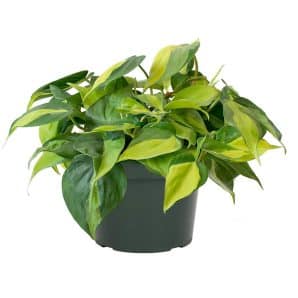
Philodendron Micans: Micans is another low-maintenance Philodendron. It has unique velvety heart-shaped leaves that come in striking colors from greens to red and even brown hues. It is great as a cascading vine from a hanging basket and requires simple care in terms of light and water needs.
philodendron-micans-plant.jpg
Philodendron Camposportoanum: Another rare species, this Philodendron is a non-climbing tropical houseplant. It grows small heart-shaped leaves that change colors from dark green to pink as the plant matures. Growing requirements are similar to the other Philodendrons mentioned here.
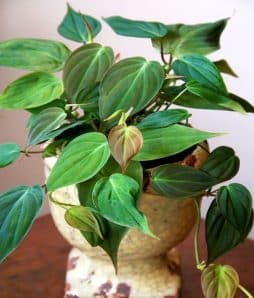
Common Problems
With its low-maintenance care, the Silver Sword Philodendron also comes with the ease of not being prone to many diseases, pests, or problems. Its biggest issues include yellow or brown leaves or leaves that start to curl. Most of the time the cause of this is either too little or too much water or sunlight. Both easy fixes.
Diseases
In terms of diseases, the most common would be fungal or bacterial infections which are caused by root rot. Root rot can be avoided easily by only watering the plant when absolutely necessary. Use the finger tip test to check if the top 2 inches of the soil are moist. If not, give the plant a drink. If so, wait until tomorrow to water.
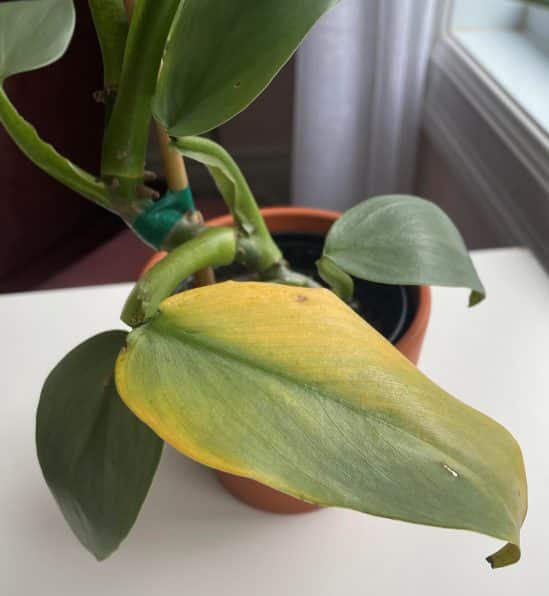
If your plant does appear to be coming down with a disease you can stop it quickly by trimming any browning or yellowing leaves and making sure water and light conditions are sufficient.
Pests
This plant is susceptible to many of the same pests that most Philodendron plants, and the majority of indoor houseplants, are susceptible to. Common Silver Sword pests include the common spider mite, scale bugs, thrips and mealybugs that are known to feed on the plant’s leaves and suck it dry of the nutrition it needs.

Treating these pests is as simple as caring for the plant. Start by wiping the leaves off with a damp cloth. If that doesn’t do the trick add a little neem oil to the cloth. A spray bottle with diluted rubbing alcohol or an insecticidal soap are also effective treatments.
FAQ’s
Are Silver Sword plants rare?
As they lose their natural rain forest habitats they are becoming rarer in the wild. However, Silver Sword plants are becoming more common to find in local nurseries and on websites that sell tropical houseplants.
How tall does a Silver Sword plant get?
When allowed to grow and climb up a moss pole or trellis, the Silver Sword plant can reach heights of up to 10 feet tall.
Where does the Philodendron Silver Sword grow?
The Philodendron Silver Sword grows in the tropical rainforests of Brazil. Specifically near the city of Rio de Janeiro.
Why might the Silver Sword Plant become extinct?
The rain forests of Brazil, where the Silver Sword plant is native to, are being heavily forested. If these tropical forests continue to be destroyed for land development, the Silver Sword plant will not be able to thrive and will become extinct.
The Silver Sword plant is a member of the Philodendron species which are part of the Araceae family. It grows in tropical climates and is native to Brazil. The Puya Raimondii on the other hand is a bromeliad that is native to the rocky slopes of Bolivia.
These are two very different species of plants. However, they may often be confused because they are both described as a Silver Sword or Silversword. The Philodendron has lush, silvery green sword-shaped leaves, while the Raimondii has stiff, pointy, sword-shaped leaves that are green on the top with a silvery hue on the bottom.
Other than their common name, similar color, and the fact that both are endangered, they are not related.

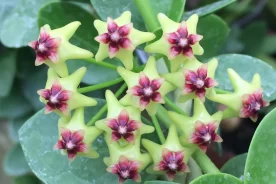
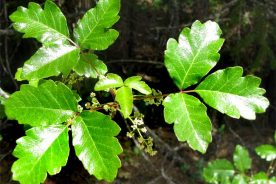


No Comments